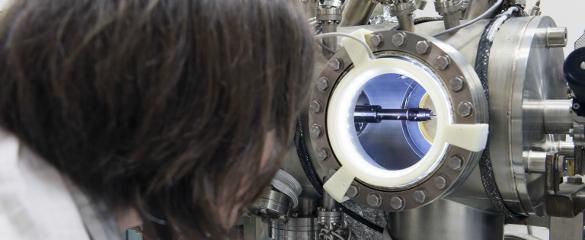All modern computing devices get their power from silicon chips, which are filled with transistors, and these transistors are very small – no more than a few dozen nanometres in diameter, or about a thousand times smaller than the width of a human hair.However, for some people, that’s not small enough. Every two years or so, computer engineers have managed to double the number of transistors on chips in order to make the chips faster – a trend famously noted by the Intel Corporation co-founder Gordon Moore. To keep up with the squeeze, those engineers have had to employ smaller and smaller transistors.That is why scientists are trying to make transistors and other electronic devices from single atoms and molecules. ‘An entire computer based on molecular electronics would overcome Moore’s Law,’ said physicist Angelika Kühnle at Johannes Gutenberg University in Mainz, Germany.Breaking the lawThe idea with molecular electronics is to link together complex molecules that perform the same switching function that is performed by transistors and other semiconductor devices. Take rotaxane – a dumb-bell-shaped molecule that has an additional circular molecule wrapped around its axis. This circular molecule can slide from one side of the dumb-bell to the other, giving the composite rotaxane molecule states for ‘on’ and ‘off’, or binary ‘1’ and ‘0’.“‘Europe today is the only place we can compare all three techniques.’Xavier Jehl, French Alternative Energies and Atomic Energy CommissionThe problem with rotaxane and other molecular switches in the past has been to reproducibly wire them together. The PAMS project is attempting to make a fundamental building block of an entirely new and highly compact form of electronics, by adding electrical contacts to the molecular switch. It was funded as part of the EU’sFuture and Emerging Technologies (FET) initiative, which aims to stimulate radically new technology through collaborations between advanced science and cutting-edge engineering.Although less than a year into the project, Kühnle and her colleagues on PAMS have already used the incredibly fine tip of a scanning tunnelling microscope (STM) to position molecular contacts on a surface. But Kühnle said that reproducibility is still proving to be a big issue. ‘We’re far from a working circuit, I would say.’Old ideaIn fact, scientists have been trying to fabricate molecules and wire them up on surfaces since the first proposal for molecular electronics in the mid-1970s. Given that progress has been slow, some researchers are trying a different tack – one that involves embedding the single atoms or molecules inside other solids.This is where the FET-funded SiAM project comes in. It intends to add a single atom of another element to a silicon crystal, a process known as ‘doping’. Since the switching properties of transistors and other electronic devices derive from semiconductors like silicon being doped with other elements in bulk, SiAM’s single-atom transistor will be rather like a conventional transistor in its smallest possible form.There are three ways to dope silicon with single atoms: by traditional deposition in a silicon plant; by growing the crystals from scratch; and by positioning the dopants with an STM. Fortunately, SiAM has access to labs that are world leaders in each. ‘Europe today is the only place we can compare all three techniques,’ said atomic physicist Xavier Jehl at the French Alternative Energies and Atomic Energy Commission, coordinator of the project. The idea is to develop three different kinds of devices and explore the synergies between them.Like PAMS, SiAM is in its early stages and does not yet have any published results. But Jehl said that the three fabrication methods are looking promising. ‘It’s going pretty well,’ he said.Another crystalSingle-atom dopants do not have to be embedded in silicon, however. Diamond has an almost identical atomic structure – and if you dope this carbon-based crystal, the applications could be very colourful indeed.The FET-funded project DIADEMS is investigating what happens when diamond is doped with single atoms of nitrogen. Trapping nitrogen in this way creates a neighbouring vacancy in the crystal lattice where quantum-mechanical properties flourish – for instance, the vacancy develops a long-lasting quantum ‘spin’.Since a magnet is essentially the manifestation of billions and billions of atomic spins, this lone spin in diamond could be used as a tiny device that senses magnetization – a magnetometer. And as a magnetometer, it could optimize the reading of data from high-density storage drives; or image the spins of electrons in the latest quantum-level ‘spintronic’ computing devices; or even study the magnetic fields generated by neurone activity in the brain – an ability that could benefit research into neurodegenerative diseases such as Alzheimer’s.Scientists working on DIADEMS are just beginning to understand how to best exploit nitrogen-doped diamond through theoretical modelling and sensing different samples. Quantum physicist Thierry Debuisschert at Thales, a France-based electrical research company and coordinator of DIADEMS, said that the research is only possible because of the ‘unique mix’ of partners from industry and academia available in Europe. ‘We have a lot to learn from each other,’ he added.
This article was originally published in Horizon, the EU Research and Innovation magazine.
Add to favorites:
Share:
Listing Description
Video
Documents
No documents available.
Ask KETMarket to make a contact
Connect with the Listing Owner!
💬 Please log in now to askKETMarket to make a contact. Not a member yet? Sign up for free and start connecting today!
Video
Related Funding and Finance Opportunities
Unlock Exclusive Funding Opportunities!
🔑 Get instant access to tailored funding opportunities that perfectly match your needs. This powerful feature is exclusively available to our premium members—helping you save time, stay ahead of the competition, and secure the right funding faster.
Upgrade to Premium now and never miss an important opportunity again! Already a premium member? Log in here to explore your matches.
Related Innovation Offers
Discover Tailored Innovation Offers!
🚀 Gain access to technology solutions that match your specific needs and interests—carefully selected to support your innovation goals. These offers are exclusively available to our premium members, helping you identify relevant technologies faster and start the right conversations with potential partners.
Upgrade to Premium now and explore your personalized technology matches today! Already a premium member? Log in here to view your tailored offers.
Related Knowledgeable Resources
Discover More with Premium: Related Knowledge Resources
🔒 You’re missing out on expert-curated knowledge specifically matched to this topic. As a Premium member, you gain exclusive access to in-depth articles, guides, and insights that help you make smarter decisions, faster.
Whether you’re preparing a funding proposal, researching a new market, or just need reliable information—our Premium knowledge matches save you hours of research and point you directly to what matters.
Upgrade to Premium now and instantly unlock relevant knowledge tailored to your needs! Already a member? Log in here to view your personalized content.

